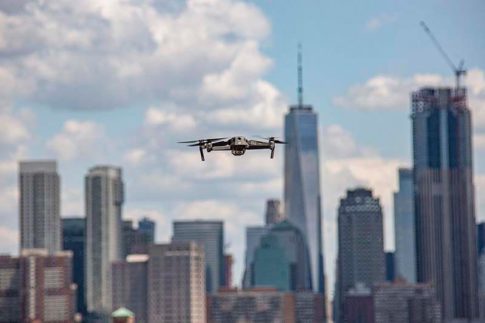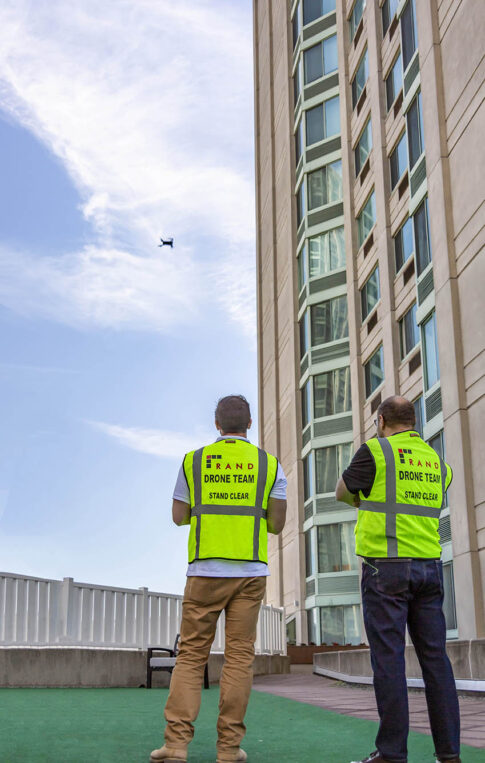
In an exciting development, New York City Mayor Eric Adams has introduced new rules that expand the permitted uses of drones for various services, including building inspections and infrastructure assessments. These changes represent a significant step forward in enhancing building envelope inspection services, allowing for much more detailed visual observation than could otherwise be performed without expensive rigging installations, and creating valuable visual records that can be monitored over time for signs of building deterioration.
The Advantages of Inspections by Drone
Drones offer significant advantages in building inspection work, providing a unique vantage point unavailable using traditional methods. Some key benefits of utilizing drones for building envelope assessments include:
Aerial Perspective and Close-Up Inspections: Drones equipped with high-resolution cameras can capture detailed images and video of building facades from various angles and heights, providing both an aerial perspective and the ability to see conditions close-up without physical proximity. This comprehensive view enables inspectors to identify potential issues, such as cracks, spalling, or water infiltration, that may not be easily visible from the ground, roof level, or isolated access points along the facades. Drone inspections offer a more thorough and accurate assessment of the building's condition, contributing to more effective maintenance strategies and long-term preservation.
Enhanced Access and Safety: Drones offer a safer alternative for inspecting buildings with challenging architectural features or difficult-to-reach locations that may pose risks to inspectors using traditional methods. Using drones, inspectors can navigate around obstacles and directly approach areas that could be unsafe or inaccessible, for a comprehensive visual assessment while minimizing potential hazards. This approach significantly reduces the risk of accidents and injuries associated with traditional inspection methods, such as working at heights or in confined, precarious spaces.
Real-Time Analysis: During drone inspections, live video feeds allow inspectors to observe the facade in real -time. This feature enables immediate identification of potential issues, leading to quicker decision-making and follow-up action where warranted.
Historical Data and Monitoring: Drones equipped with high-resolution cameras and sensors capture detailed visual data of a building's facade over time. Carefully planned and replicated flight paths enable inspectors to review footage and identify potential issues during the inspection. Following each flight, comprehensive 3D models and orthomosaic photos of the entire building elevations can be generated by data analysis software. This historical flight data can be visually compared or aided by AI to develop trend analysis, helping to detect changes and predict potential deterioration. Regular drone inspections facilitate more informed decision-making, proactive maintenance strategies, and the long-term preservation of building structures. By catching small problems early on, this technology helps prevent minor issues from escalating into more significant and costly concerns.

RAND's Drone Team performs a structural and facade evaluation per Jersey City Ordinance 21-054.
The Versatility of Drone-Based Aerial Surveys and Inspections
Drones enhance the field of building evaluations, offering a versatile range of capabilities for aerial surveys and inspections. With their advanced technology and high-resolution cameras, drones can assist in a multitude of tasks, including:
- Facade inspections
- Roof inspections
- Leakage investigations
- Property condition assessments
- Curtain wall analysis
- Facade repair quantifications
- Special inspections
- Interior space evaluations
- Emergency investigations
- Pre-incident assessments
- Post-incident forensic investigations
- Post-disaster recovery and insurance claims
- New construction and renovation progress documentation
- Exterior air infiltration/exfiltration analysis
- Roofing level thermography and analysis
It is important to keep in mind that while drones provide significant benefits, they are solely a visual tool, and as such do not replace the hands-on inspections mandated by NYC's Facade Inspection Program (FISP), which requires cyclical hands-on inspections of buildings taller than six stories along every 60 feet of street- and public-facing facades. But they add a marvelous tool to an inspector’s arsenal, allowing for detailed, close-up visual assessments that will go a long way toward accurately detecting the condition of building components so owners can maintain the integrity of their structures.
Contact RAND
RAND's Drone Team has been in operation since 2019, conducting successful building envelope evaluations outside of New York City. With these new rules in place, we are thrilled to extend our specialized drone services to the New York City community.
To find out if your building would benefit from drone inspection services, please contact RAND at 212-675-8844 or info@nullrandpc.com.
Robert Krupp, PE, is a Project Engineer, certified drone pilot, and member of RAND's Drone Team.
